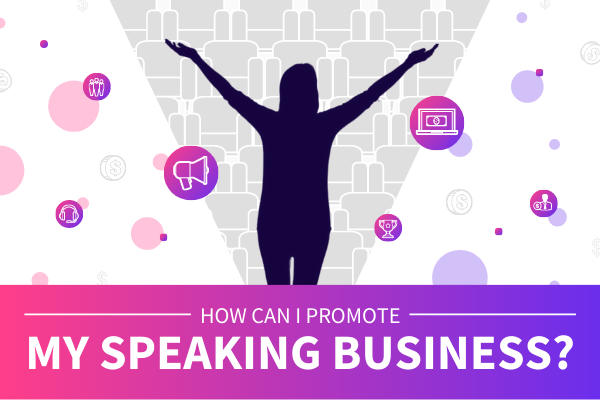For many small business owners, one of the biggest challenges, initially, is sorting out what recommendations truly work, and speaking businesses are no exception. When it comes to sales, for example, many speakers ask, “What are the best ways to find leads?” Likewise, when it comes to marketing, many ask, “How can I promote my speaking business?”
Simply put, promoting your speaking business relies on three main strategies, including building a personal brand, curating – and consistently executing on – a content strategy, and competing with other speakers in your area of expertise. When done well, each of these marketing strategy components not only attracts potential clients. They also demonstrate your professionalism and authority in your focus industries.
With that in mind, the following guide describes the basic, intermediate, and advanced components of speaker marketing, including the strategies mentioned above. You’ll also find recommendations based on the age and complexity of your speaking business. That way, you can rely on this quick and simple guide as your business grows in the months to come.
Basic Speaking Business Promotion
First and foremost, let’s start with the basics. At its core, answering the question, “How can I promote my speaking business?” is about learning who you are and what your brand stands for. From your business practices to your outlook on life, like attracts like. In other words, the more you define your brand ahead of time, the more easily event organizers will be able to identify with it. That means more interest in your speaking programs, more gigs on your calendar every year, and more predictable revenue in your bank account each month.
Defining Your Personal Brand

If you don’t already have one, essentially, a personal brand allows you to put a professional finish on your business persona. It includes the messaging on your promotional materials, the colors and fonts used in any graphic designs, and the general “feel” people get when interacting with you or your brand.
In short, your personal branding should communicate who you are and what you stand for. The SpeakerFlow brand, for example, uses bright colors, gradients, organic shapes, and modern fonts. Although it’s not a personal brand, each of these elements – combined with our messaging – conveys our commitment to cutting-edge trends, business recommendations, and designs. This allows speakers with similar values to look at our brand and immediately see themselves as a natural fit for our products, services, and resources.
In the same way, your personal brand can draw in event organizers that are a natural fit for your offerings. Below are five steps to help you design your personal brand (or, if you have one already, give it a makeover).
1. Choosing Your Brand Colors
When considering colors, keep in mind the connotations associated with each color. Red, for example, tends to symbolize power and confidence. On the other hand, greens and blues suggest serenity and connection to nature. Depending on the message you want to convey to your audience, choose colors that match your desired “vibe.” Then, using those base colors, build a color palette to use throughout your brand. Color guides from Canva or 99Designs can help you get started, if you’re unsure where to begin.
2. Choosing Your Brand Fonts
Like colors, your brand fonts are a reflection of your personality and your overarching message. Consequently, the fonts best suited to your brand will be ones that coincide with the emotion and tone established by your brand colors. The two basic categories of fonts are serif and sans serif, the former of which is more classic and literary while the latter is more modern and streamlined. To find which font categories (and which individual fonts) are a good fit for your brand, I recommend starting with 99Design’s beginners’ font guide. From there, Canva’s font combination guide can help you select one or two additional fonts to use in your brand.
3. Perfecting Your Messaging
Throughout your brand, your messaging should not only be consistent with the tone established in your colors and fonts but also with your speaking style. Looking back at SpeakerFlow’s brand, for instance, our brand colors and fonts are informal and bright. Likewise, our message is generally optimistic and relaxed. With your own brand, consider the colors and fonts you’ve chosen and your tone when speaking. Then, write out tone words you want to convey in your messaging, so you can refer back to your “tone word list” as you craft the written material for your promotional materials.
4. Drafting Your Story Arc
The fourth step in crafting a personal brand is – surprise, surprise – making it personal. As part of your brand, write a biography in accordance with the tone word you chose above. This bio should not only share how you came to be where you are today but also demonstrate the authenticity of your brand. In short, your bio shows the reader that your brand matches your personality, that by working together, they’ll always see the authentic, truthful you. Find out more about writing a speaker biography in our beginners’ guide.
5. Defining Your Promise Statement & Value Proposition
In total, your brand should communicate your personality and what makes you unique. However, it should also include information about who you serve and how you serve them. This information is summarized in your value proposition and your promise statement, the first of which is a long form explanation of your value while the second is usually only a few words. Learn more about the differences between these two statements in our previous guide, “5 Key Components Of The Perfect Promise Statement.”

Launching A Website
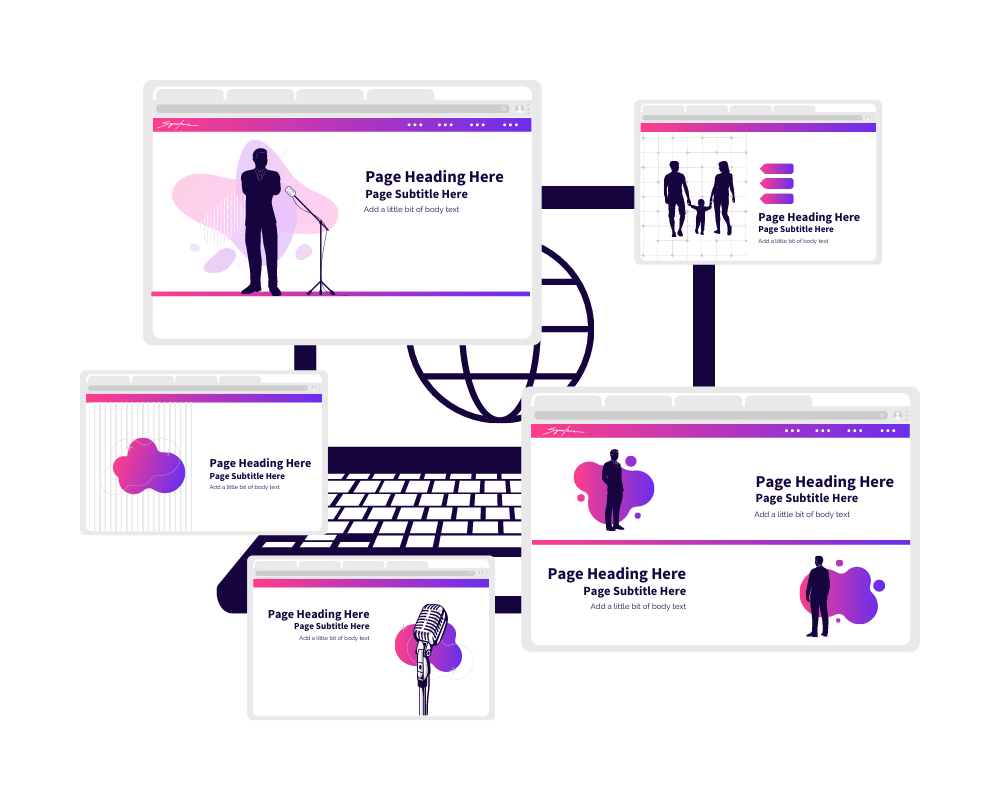
For new or growing speakers answering the question, “How can I promote my speaking business?” the next step is building your brand into a website. Although speaker websites can differ greatly, depending on who you ask, most are designed to do three things.
First, your website needs to establish your personal brand. As we discussed above, this conveys your personality and provides uniformity across your promotional materials and channels. In the case of your website, specifically, implementing your brand also means including photos of you in action. This provides a visual for event organizers as they consider you for their own event. Plus, it breaks up the text of your website to keep the viewer engaged.
Second, your website should explain everything you offer. This can include speaking or consulting programs, online coursework, books, etc. Whatever you sell, your site should provide basic information about it and how to either purchase it or learn more. It should also be clear about who each product or service serves and which “packaged” options you offer. One common example among speakers, for example, is a speaking program and copies of the speaker’s book for everyone in the audience for a single fee.
Third, your entire website should consistently promote the same call to action. For many speakers, this is some form of “Talk To [Speaker Name Here]”. Whether you use this exact language or not, your call to action should link to a page with your contact information. You can also include a contact form at the bottom of each website page to make it as convenient as possible for site visitors to reach out for more information about your programs.
Speaker Website Checklist
All in all, when building your website, one of the best sources of inspiration is the sites of other speakers. In our list of speaker websites, for instance, you can find 25 high-quality examples along with action items to put the best practices of each example into your own site.
That said, wherever you choose to find inspiration, there are a handful of requirements that every great website meets. Below are our recommendations, written as questions for you to ask yourself as your own website construction is in progress.
- Does the top of my homepage include my promise statement (and is my full value proposition listed somewhere lower on the page)?
- Do I have a clear call to action in the navigation bar? Does it appear consistently across all of my website pages?
- Are each of my products and services clearly outlined along with descriptions of who they serve?
- Are my brand colors, fonts, and messaging style consistent across all pages of my website?
- Did I include proof (testimonials, social media reviews, client videos, etc.) to show previous happy clients?
- Did I include a page dedicated to meeting or event planners, so they can easily download my speaking materials?
Intermediate Speaking Business Promotion
After building your website, it’s time to launch into the intermediate stages of promoting your speaking business. These include designing a content strategy and, by extension, establishing both your digital presence and your authority in your focus industries.
Essentially, while the basic answer to “How can I promote my speaking business?” is about laying a foundation, the intermediate answer is about expansion. How can you expand your credibility and influence? How can you expand your thought leadership beyond the stage? And how can you expand your marketing funnel so that new leads come in effortlessly? To answer these questions, let’s dive into content marketing.
Strengthening Your Content Strategy
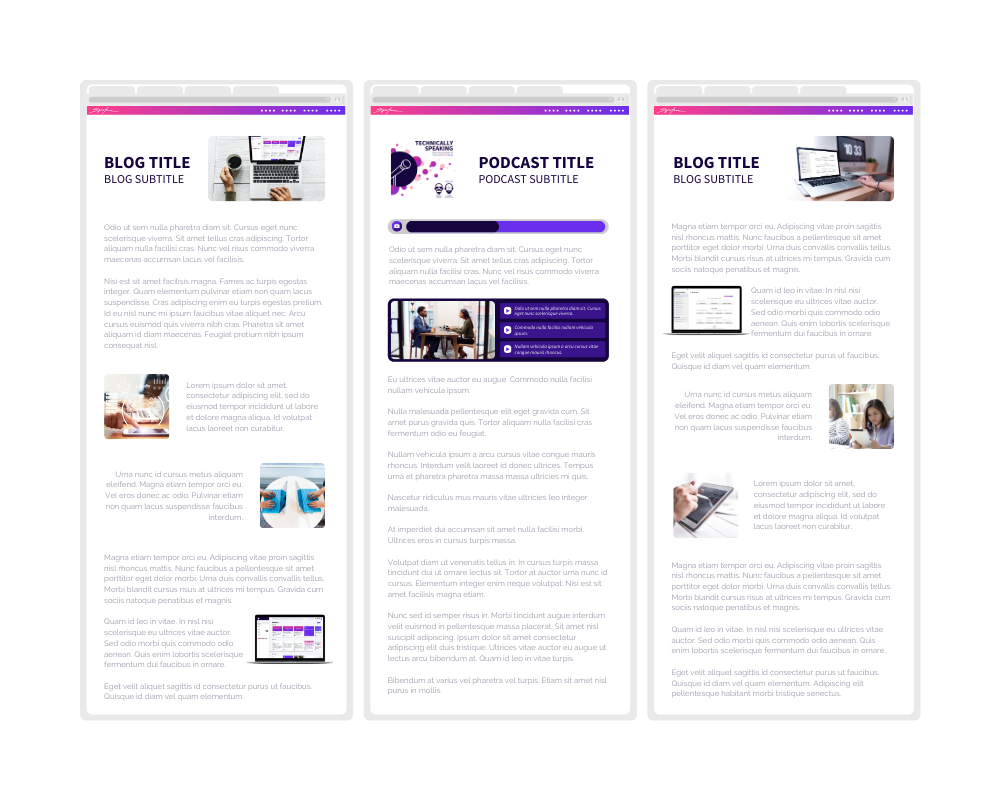
Generally speaking, creating content focuses on resources in four categories. For each of these areas, your goal is to not only share information pertaining to the topic at hand but also encouragement. To put it simply, the best content provides viewers with direction so they can move forward decisively, not just consume your content and think, “Well that was interesting. Now what?”
To meet this goal, in each of these four areas, it’s important to do your research ahead of time. This includes choosing a keyword or phrase when appropriate, making an outline of the project in advance, and following best practices for search engine optimization (SEO). That way, after publishing your content, it’s more likely to rank in Google search results for the given keyword. If you’re new to SEO – or simply need a refresher – Semrush’s basic SEO guide is a solid starting point.
It’s also useful to connect these channels with one another. If you’re writing a blog, for instance, and you have a video on the same topic, embed the video in your blog. Then, once you’ve finished writing, add the blog’s URL to your existing video’s description. Not only will this add to the keyword density in each piece of content. It’ll also allow you to appeal to audience members with different content preferences. Win, win!
This applies across all of these content types and should be an ongoing effort, as you continually expand your content library. Below, we’ll look at each content category in more detail, so you can start as soon as possible.
Blog Articles
If you haven’t written a blog before, the best blogs focus on a single keyword or phrase, which should account for 1% of the body text in the blog. It should also appear in the blog title and subheadings and in the alternative text (or alt text) for images or graphics throughout the blog. Provided that the blog is well-written and includes 1,500 words or more, these attributes increase the likelihood that the blog will rank in a Google search. For specifics, before you write your next blog, check out HubSpot’s blog SEO guide.
Videos
An increasingly popular form of content creation, videos are exceptionally useful in that they allow you to share a large amount of information in a short amount of time. They also allow you to appeal to different types of learners in your audience by including visual and auditory elements. Compared to a blog, this can make it easier to retain viewers’ attention and get your main point across. This is made even more true when you SEO optimize your videos, as described in this video SEO guide from Backlinko.
Podcasts
Similarly to videos, podcasting has absolutely exploded in popularity over the last 20 years. As audio recordings, podcasts allow you to share information that listeners can take in anytime, anywhere. Plus, you can always link back to blogs or videos in each episode’s description, should listeners want that info in another format. Although podcasts are audio-only, there are proven SEO strategies to help you make the most of each episode. If you’re interested in starting a podcast (or in optimizing your existing episodes) I recommend referring to Neil Patel’s podcasting SEO guide to learn more.
Additional Resources
The last area of content is downloadable resources. While SEO optimization isn’t as important for this type of content as for the aforementioned three categories, creating resources is an excellent way for you to support your audience free of charge. When linked in a blog, video, or podcast, an additional PDF (or similar file) can allow you to expand upon your original content or provide “action items” to help readers put your words into action (like in a workbook, for example). Additionally, you can use resources as a way to capture leads. What’s not to love about that?
Building Your Reputation As An Expert

Besides creating content, the flip side of intermediate speaking business promotion is contributing to others’ content. As mentioned above, one aspect of thought leadership is positioning yourself as a leader in your focus industries. More than anything, you do this by collaborating with other experts in your field to share your insights.
For example, if your focus is human resources and HR events, you might reach out to the International Association for Human Resource Information Management (IHRM) or the Society for Human Resource Management (SHRM) to guest write for their blog. Other examples include appearing as a guest on a podcast or YouTube channel. You can even offer to create exclusive content for members of industry organizations, as we’ve done for the National Speakers Association (NSA) or Canadian Association of Professional Speakers (CAPS).
However you prefer to contribute to other industry publications, the goal is to provide support for your audience. Like finding your first job, sometimes success comes through volunteering. In thought leadership, that can mean volunteering your time, insights, and experience to help make your industry a better place. It sounds time-consuming – and, admittedly, it can be. But, in the long run, this shows that you’re not just there to speak, get paid, then leave. You’re around for the long haul and dedicated to sharing high-quality, actionable information for your audience.
More importantly, in the eyes of potential clients, this demonstrates your commitment and reinforces how easy you would be to work with, making them more likely to hire you. In cases like these, promoting your speaking business only costs you time, but the result can be a deal worth tens of thousands of dollars. Pretty solid return on investment!

Advanced Speaking Business Promotion
Finally, the last – and most advanced – answers to the question, “How can I promote my speaking business?” are those reserved for established speakers. Because every speaking business is unique, there are almost inevitably going to be marketing strategies that don’t apply to your business, specifically.
One of the most common, for instance, is paid advertising, which is best used for product sales. Another one is looking to your competition to, essentially, use their past successes as a springboard for getting hired at future events. Below, we’ll cover both of these examples, because of how frequently they’re recommended in speaking circles. That way, you can avoid wasting time or money on a strategy that doesn’t apply to you.
Advertising for Your Products
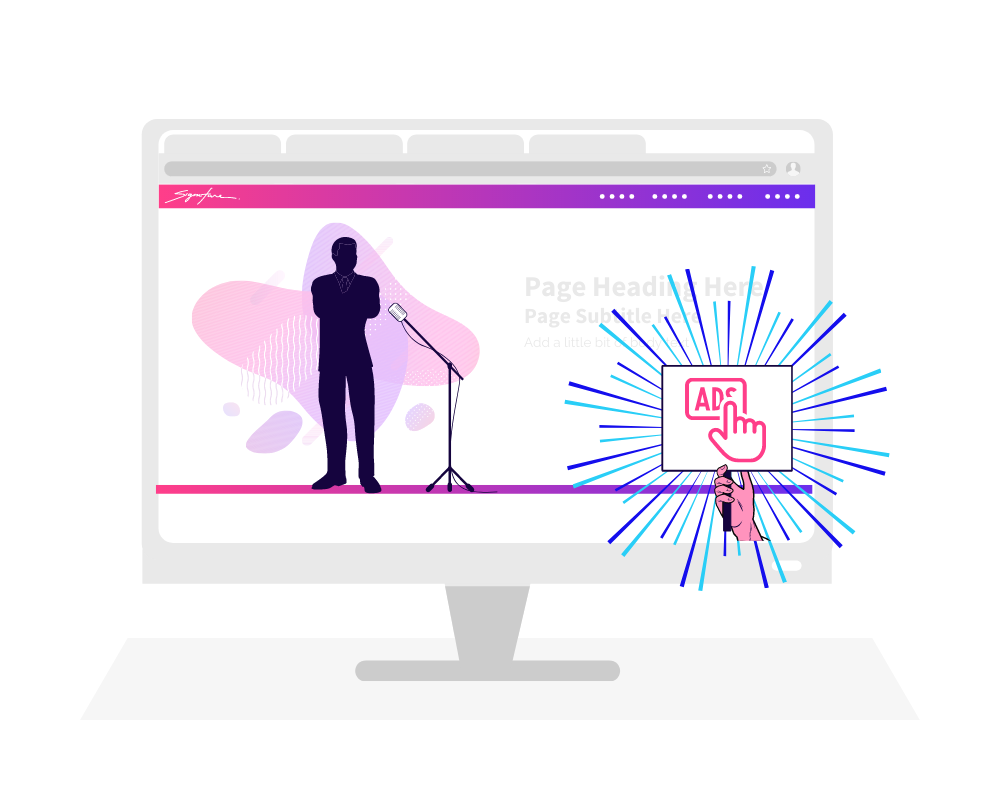
To kick things off, let’s talk about paid advertisements. If you haven’t used them before, paid ads include banner ads, text ads, social ads, video ads, not to mention the popular Google ads that have taken over the average list of Google search results. For each of these ad types – and depending on the platform that houses them – the cost of running an ad can vary widely. And, if you choose to run ads for the wrong keywords, that cost can add up quickly.
To avoid this, marketing expert Neil Patel says, “The key that you have to remember is you will get a lot more bang for your buck by targeting a large number of lower-traffic terms than by targeting a small number of higher-traffic terms.” In other words, your best bet is to look for keywords in your focus industry that aren’t difficult to rank for. Then, use ads to target many of them.
To find keywords, Patel also mentions, “The best source of keywords can come from your own website…. find out what your customers are looking for or why they decided to do business with you… The language they use can be very effective ad copy for internet advertisements.” From there, to learn more from Patel about launching paid ads in your speaking business, his quick and simple guide, “5 Things You Must Do Before Jumping Into Paid Internet Advertising” is a great next step.
How To Know If Paid Ads Are Necessary:
While much of the strategy we’ve mentioned so far suits all speakers, paid advertising is best suited to established speakers selling a product, such as a book or online course. In our experience, it does not work well for booking events, consulting, or coaching gigs as a general rule.
Additionally, testing a paid ad strategy generally requires a large budget (usually anywhere from $1,000 to a few thousand dollars a month) simply to start. This is because it’s impossible to know, from the beginning, which keywords, ad platforms, and ad types will bring the most qualified leads to your website. It takes testing, time, and money to troubleshoot and narrow down your speaking business’s unique answer. Keep this mind when deciding how paid ads fit into your long term promotional strategy and if they’re a responsible choice at this time.
Using Competitor Research To Your Advantage
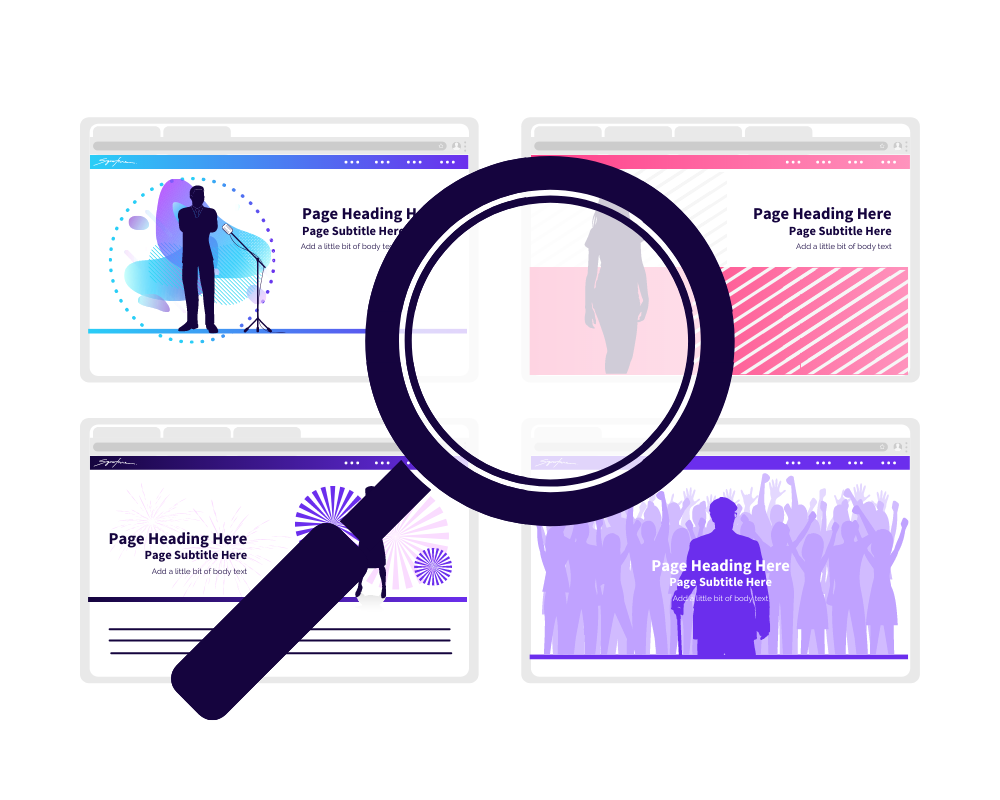
The final strategy is using competitor research. It can be tempting to think that every speaker has their own unique selling point, but there are undoubtedly speakers out there seeking an audience similar to yours. Maybe it’s their branding, backstory, or speaking programs. In whatever ways they’re similar to you, the following rule applies: If you could both speak to the same audience, you’re competitors.
While this sounds harsh, it’s actually a good thing! Looking at your competitors, especially the ones that are out-selling you, look for ways to learn and strategies to steal for use in your own speaking business. Below are a few examples.
- Compare your content. Is there anything they’re doing that makes their content more engaging or informative (including more graphics or using a less formal writing style, for example)?
- Looking over their website, how do your brand colors, fonts, and styles compare? Is there something you could adjust or update to make yours more uniform or more cohesive to the other elements of your brand?
- Are there ways in which their website is easier to navigate, such as the language or page layouts they use?
It’s even possible to steal a competitor’s client list! Simply put, using the Speaker Intel Engine, you can search for a competitor, see where they’ve spoken in the past, then find the contact information for those clients. From there, all it takes is a quick email to say, “Hey, I saw So-And-So spoke for you in the past. Since we speak on a similar subject, I can help, too!”
I’ll leave it at that, for the sake of time. But if you want to learn more and test out the Engine yourself, check out this demo video from the Engine’s creator, speaker and sales expert Sam Richter.
Speaker Marketing Resources
Overall, answering “How can I promote my speaking business?” takes time, and depending on your focus industries, the best strategies may vary. In many industries, for example, there isn’t a ton of high-quality digital resources, making content creation a great way to expand your expertise and grow your speaking business, even if it’s a bit of a “long game.” Alternatively, in other industries, your brand may be the greatest thing that sets you apart from your competitors.
Ultimately, the key thing to keep in mind, when promoting your speaking business, is that iteration is key. For each of the aforementioned strategies, all you can do is try, and if your efforts pay off immediately, that’s great! If they don’t, change part of your strategy, then try, try again.
Additionally, remember that the thought leadership industry is known for its connections. Among speakers, authors, coaches – you name it! – networks run far and wide, and within those networks, the vast majority of people are happy to share resources, tips, and tricks from their own experience. All you have to do is ask!
Keeping that in mind, below are two final resources from our team to help you hit the ground running. For more information about promoting your speaking business, as always, subscribe to our blog or drop us a line. 👍
Speaker Operating System

Launched in 2020, SpeakerFlow’s operating system is a customized approach to building speaking businesses. With more than a dozen applications tailored to expert business owners – and 30+ other apps available, should they be needed – this system is designed to allow you work from one place.
It’s also organized so that you don’t have to go it alone. Each new SpeakerFlow user is walked through a three-month process of customizing their account, migrating their current systems, and training to make the most of their new setup. That way, despite how overwhelming a new system can be, you can start efficiently and confidently.
For more information about SpeakerFlow’s operating system, visit our systems page. Alternatively, for testimonials from our current clients, feel free to contact us at [email protected].
Speaker Community & Resources
In addition to engaging with other speakers, SFU members also get exclusive access to a wide range of resources. This includes written content similar to this guide, custom videos in response to their questions or concerns, and support from SpeakerFlow’s team for one-off questions.
With each of these components, SpeakerFlow University was designed to provide expert business owners with a welcoming, encouraging, and reliable source of information about running a speaking business. That way, they can grow their respective businesses with confidence and grow their speaking support network simultaneously.
To learn more about SFU – or, even better, to join in the near future – visit our University page.
Ultimate Guide to Speaker Marketing
As marketing goes, speaker marketing can be exceptionally daunting, largely because of the limited information about it. To aid in this content gap (in addition to our other guides), we created the Ultimate Guide to Speaker Marketing.
In this blog, you’ll find additional information about many of the topics we covered here, including building a personal brand and creating content. However, you’ll also find detailed explanations of a number of other marketing components. These include, to name a few:
- Choosing a Domain Host
- Choosing a Website Builder
- Building A Social Media Presence
- Paid Advertising vs. Search Engine Optimization
- The Basics of Keyword Research
To learn more about each of these topics, dive into the Ultimate Guide. And, if there’s another area of speaker marketing we should write about, let us know! We’re all about sharing the latest and greatest resources for thought leaders. So, if there’s something we can do to help in your speaking business, just say the word. 👌


